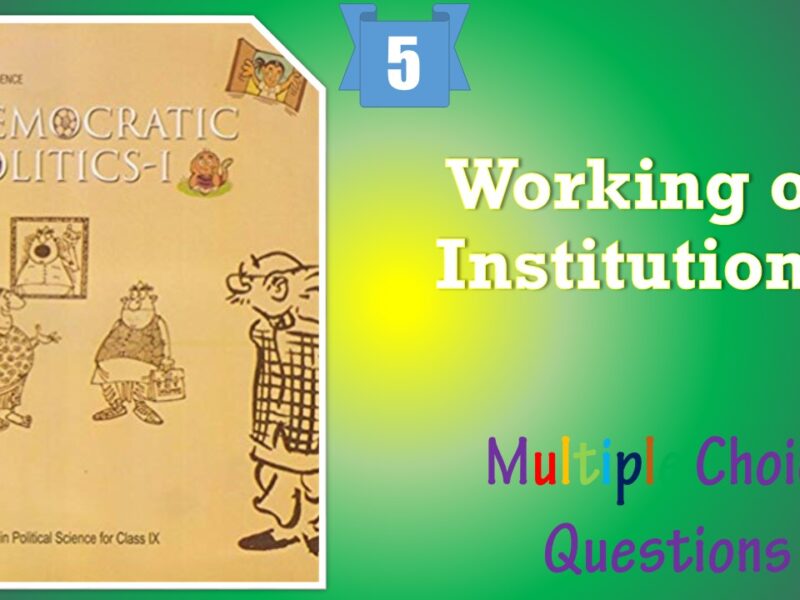CBSE Class 10 Social Science Chapter 5 Popular Struggles and Movements Multiple Choice Questions with Answers. MCQ Class 10 Civics Popular Struggles and Movements with Answers was Prepared Based on Latest Exam Pattern. Students can solve NCERT Class 10 Civics Popular Struggles and Movements MCQs with Answers to know their preparation level.
Students who are searching for NCERT MCQ Questions for Class 10 Civics Popular Struggles and Movements with Answers are compiled here to get good practice on all fundamentals. Know your preparation level on MCQ Questions for Class 10 Social Science with Answers. You can also verify your answers from our provided MCQ Class 10 Civics Popular Struggles and Movements with Answers. So, ace up your preparation with MCQ of Chapter 5 Civics Objective Questions.
MCQ Class 10 Civics Popular Struggles and Movements with Answers - Set - 1
Question 1:
Backward and Minorities Community Employees Federation (BAMCEF) is an example of which one of the following? [Delhi 2011]
(a) Public interest group
(b) A movement for equality
(c) A sectional interest group
(d) A political party
Correct Answer – (A)
Question 2 :
In Bolivia protest against water privatisation was led by: [CBSE 2012]
(a) Trade Unions
(b) FEDECOR
(c) Human Rights Organisation
(d) Anti-liquor movement
Correct Answer – (B)
Question 3 :
Which pressure group seeks to promote collective good?
(a) Sectional Interest (Pressure Group)
(b) Public Interest Group
(c) Movement Groups
(d) Loose Organisation
Correct Answer – (B)
Question 4 :
What were the aims of the movement started by SPA?
(a) Restoration of Parliament
(b) Unlimited power to monarch
(c) Power to an all-party government
(d) A new Constituent Assembly
Correct Answer – (A)
Question 5 :
The word MNC is related to which issue:
(a) Nepal’s popular struggle
(b) Bolivia water war
(c) Environmental movement
(d) Narmada Bachao Andolan
Correct Answer – (B)
MCQ Class 10 Civics Popular Struggles and Movements with Answers
Question 6 :
To which one of the following Continents, Bolivia belongs? [CBSE 2012]
(a) Africa
(b) Europe
(c) South America
(d) Asia
Correct Answer – (C)
Question 7 :
In which two ways, the Public Interest Groups achieve their aims? [CBSE 2012]
(i) They organise meetings to win the Public Support.
(ii) They raise slogans against the Government and disrupt public.
(iii) They try to influence the media by drawing their attention to their cause.
(iv) They set up the public property on fire.
(a) (i) and (ii)
(b) (i) and (iii)
(c) (i) and (iv)
(d) (ii) and (iii)
Correct Answer – (B)
Question 8 :
Who were Maoists?
(a) Communists who believe in the ideology of Mao
(b) Democrats who believe in the democratic form of government
(c) Members of SPA group
(d) Members of royal family
Correct Answer – (A)
Question 9 :
Which one of the following is the ‘Third Wave’ country that had won democracy in 1990?
(a) Bolivia
(b) Belgium
(c) Bangladesh
(d) Nepal
Correct Answer – (D)
Question 10 :
How did King Gyanendra take advantage of the weak democratically elected government?
(a) He dissolved the Parliament
(b) He dismissed the Prime Minister
(c) Both (a) and (b)
(d) He rigged the elections
Correct Answer – (C)
- NCERT Solutions Class 10 Civics Chapter 1 : Power Sharing
- NCERT Solutions Class 10 Civics Chapter 2 : Federalism
- NCERT Solutions Class 10 Civics Chapter 3 : Democracy and Diversity
- NCERT Solutions Class 10 Civics Chapter 4 : Gender Religion and Caste
- NCERT Solutions Class 10 Civics Chapter 5 : Popular Struggles and Movements
- NCERT Solutions Class 10 Social Science Democratic Politics II Textbook



